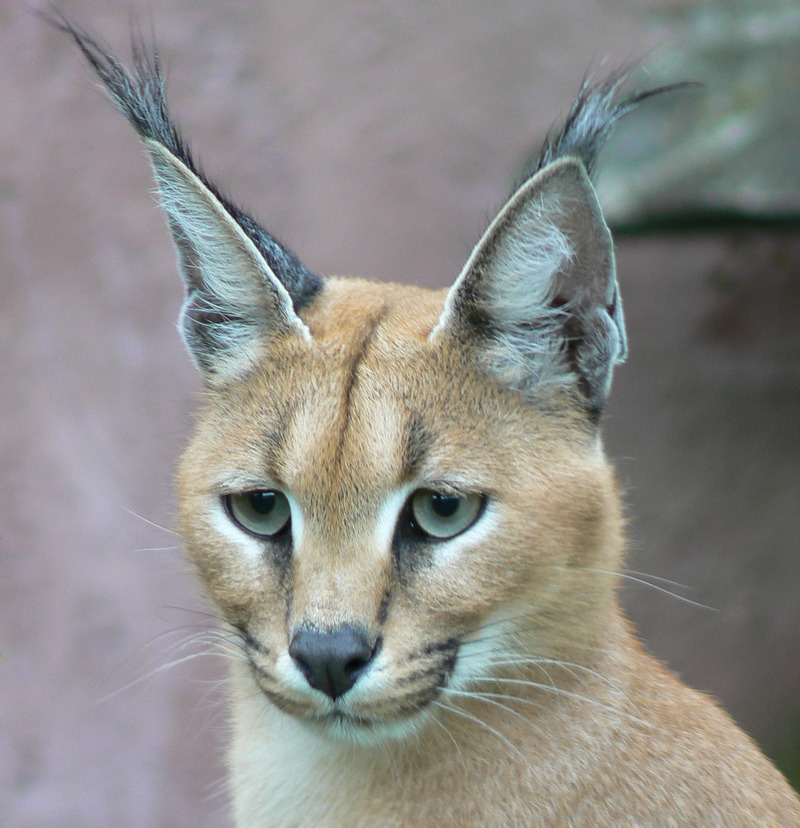|
| Query: Birds of europe | Result: 399th of 1706 | |
Caracal (Caracal caracal) - Wiki
| Subject: | Caracal (Caracal caracal) - Wiki
| |

| Resolution: 1613x1669
File Size: 507948 Bytes
Upload Date: 2007:10:10 13:15:08
|
Caracal
From Wikipedia, the free encyclopedia
[Photo] Caracal or desert lynx (Caracal caracal). Date August 15, 2006. Author € Van 3000 (http://www.flickr.com/people/23566085@N00) from belgium belgikske belgiquistan - United Tribes ov Europe
The Caracal (Caracal caracal), also called Persian Lynx or African Lynx, is a fiercely territorial medium-sized cat. The Caracal is labeled as a small cat, but is amongst the heaviest of all small cats, as well as the fastest.
Description
Males typically weigh about 13-18 kg (28-40 lbs), while females are smaller. The Caracal resembles a Eurasian Lynx and for a long time it was considered a close relative of the lynxes. Recent DNA research, however, has shown that the Caracal is not a close relative of lynxes at all, but is instead related to the Serval.
The Caracal is 65 cm in length (about 2 ft), plus 30 cm tail (about 1 foot). It has longer legs and a slimmer appearance than a lynx. The colour of the fur is variable: it may be wine-red, grey or sand-coloured. Melanistic (black) Caracals also occur. Young Caracals bear reddish spots on the underside; adults do not have markings except for black spots above the eyes.
The most conspicuous feature of the Caracal are its long, tufted black ears, which also explain the origin of its name ??? karakulak, Turkish for "black ear". Its ears are controlled by 20 different muscles to help it find its prey. The tufts of fur help pinpoint its prey.
Habitat and Diet
The Caracal is distributed over Africa and western Asia. Its habitat is dry steppes and semi-deserts, but also include woodlands, savanna, and scrub forest. It is a solitary, or paired, territorial cat. The Caracal may survive without drinking for a long period ??? the water demand is satisfied with the body fluids of its prey.
It hunts at night (but in colder seasons also in the daytime) for rodents and hares; rarely it may even attack a gazelle, a small antelope or a young ostrich. It is a picky eater, and discards the internal organs of the mammals it catches, partially plucks the fur off of hyraxes and larger kills, and avoids eating hair by shearing meat neatly from the skin. However, it will eat the feathers of small birds and is tolerant of rotten meat.
It is most well-known for its skill with hunting birds; the Caracal is able to snatch a bird in flight, sometimes more than one at a time. The Caracal can jump and climb exceptionally well, which enables it to catch hyraxes better than probably any other carnivore. Its life expectancy in the wild is 12 years, or 17 years in captivity. Since it is also surprisingly easy to tame, it has been used as a hunting cat in Iran and India.
Conservation
Because it is so easily tamed, the Caracal is sometimes kept as a pet, and is said to adapt easily to living with humans. It is often viewed as vermin by farmers in Africa because it frequently climbs over fences to eat chickens and other poultry.
The Caracal is almost impossible to see in the wild, not because there are very few of them, but because it hides extremely well. Game drives in countries such as Kenya and Botswana widely encounter other animals, but a sighting of a Caracal is extremely rare.
The Caracal has been hybridised with the domestic cat at the Moscow Zoo.
Subspecies
Caracal caracal caracal, East, Central and South Africa
Caracal caracal algira, North Africa
Caracal caracal damarensis, Namibia
Caracal caracal limpopoensis, Botswana
Caracal caracal lucani, Gabon
Caracal caracal michaelis, Turkmenistan (endangered)
Caracal caracal nubica, Ethiopia, Sudan
Caracal caracal poecilotis, West Africa
Caracal caracal schmitzi, Israel, West Asia, Iran, Arabia, Pakistan, India
http://en.wikipedia.org/wiki/Caracal
| The text in this page is based on the copyrighted Wikipedia article shown in above URL. It is used under the GNU Free Documentation License. You may redistribute it, verbatim or modified, providing that you comply with the terms of the GFDL. |
|
Comments |
|---|
| | Guest |
|
Scientific Name: Caracal caracal (Schreber, 1776)
Common Names: Caracal, Desert Lynx, African Caracal, Asian Caracal, [French] Lynx Du Désert, [Spanish] Lince Africano
Synonyms: Lynx caracal (Schreber, 1776), Felis caracal (Schreber, 1776) |
^o^
Animal Pictures Archive for smart phones
^o^
|
|
|